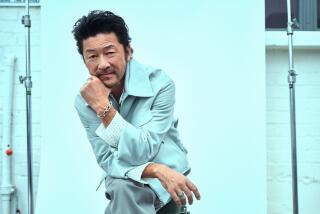‘KIKUYA’: LIVING LEGEND OF KABUKI
- Share via
VANCOUVER, Canada — Nothing sets the smallish, stocky gentleman in the yellow polo shirt apart from thousands of other Japanese tourists flooding this British Columbia metropolis in the summer of Expo 86.
Nothing apart from the respectful entourage surrounding him: manager, reporters, photographers--not to mention the two interpreters, doing their best with a bewildered waiter to ensure that the gentleman’s scrambled eggs arrive with Canadian bacon, please, and not the ordinary greasy kind.
Tomijuro Nakamura V is not yet formally classified as a Living National Treasure of the Japanese nation. But that ultimate honor probably is not far away. Now in his late 50s and at the height of his powers, Tomijuro, nicknamed “Kikuya” by his innumerable fans, is one of the greatest living exponents of the arcane art of Kabuki.
Beginning Wednesday, Los Angeles theatergoers will see him in one of his most celebrated roles: the White Lion in the dance-drama “Renjishi,” when a small touring contingent of Tokyo’s Grand Kabuki company visits the Japan America Theater for seven performances. (Tomijuro also danced the role in Shrine Auditorium on the Grand Kabuki’s 1979 tour.)
Tomijuro is nominally the star of the tour, but he doesn’t occupy the star spot on the program. That is left to the rising female-impersonation specialist ( onnagata ), Tojuro Sawamura II, who gets the chance to ring all the changes from awakening girlish sensuality to tipsy abandon in his virtuoso multiple-costume and personality showpiece “Fuji Musume.”
Even in “Renjishi,” Tomijuro’s role is not the most spectacular. The part of Red Lion (here performed by the 20-year-old Hashinosuke Nakamura III) is the showy one, with its impulsive lunges, crouching spins and sudden drops to the floor.
When he was younger, Tomijuro used to dance this role. “Only about five times,” he said modestly. (That is, in five separate productions, for a total of 125 or more performances.) He only began performing the relatively restrained elder part about 10 years ago.
But in performance there’s never a question about who’s the center of attention.
It is Tomijuro’s gaze, seeming to range an infinity of peaks, which creates the wild, lofty crag where the action takes place. His emotional intensity makes us feel a stern father’s determination to test his son’s courage to the utmost and his pride-restrained joy when the child-lion passes the test.
It would be easy to assume that White Lion is a role designed for an aging actor of flagging energies; in Tomijuro’s case, it would also be a mistake. This fall he will be playing five distinct roles in a straight run of 25 11-hour performances in his home theater in Tokyo. (His record is eight.)
Since the mid-18th Century, most of the great actors named Tomijuro were celebrated for their work in onnagata parts, but a large measure of the present title-holder’s fame is the sheer breadth of his gifts.
Perhaps Tomijuro’s very versatility explains his willingness to let younger performers shine beside him on stage. He has nothing left to prove. And indeed, talking to him is very unlike the typical “star interview.” He constantly directs attention away from himself: to his colleagues, to those who taught him his trade, to the art of Kabuki itself.
He was born in Tokyo in 1929 (or 1927; reference books differ.) His father was Tomijuro Nakamura IV, a distinguished onnagata and theater innovator. His mother was Tokuho Azuma, one of the most distinguished exponents of traditional Japanese dance. He was trained from his earliest years not only in stage work but in folk-dance and music, and made his debut at 14 in another lion-play, “Kagamijishi,” as one of the butterfly dancers who covers the costume-change for the star (on that occasion, his father).
In the immediate post-war years, his collaboration with the onnagata Senjaku Nakamura II and the director Tetsuji Takechi in a series of experimental productions helped revive interest in Kabuki as a living art form.
But when Tomijuro speaks of his work, it is not as an artist embodying a tradition, but as a vehicle or vessel for that tradition. “The spirit of Kabuki is in the music,” he said; “The music is at the bottom of it all. The music tells me what I must do.
“Today, we have videotape to make a record of our performances. But the performance is in here ,” he said, touching his chest. “Since my debut with my father I have never danced the butterfly-spirit in ‘Kagamijishi’ but I still have it in here .
“In Kabuki, the training is of a lifetime, the study is of a lifetime. You go on the stage and do every time the best you can. But the performance, where it comes from, what it means--that is a mystery. You can feel it; I can never know.”
More to Read
The biggest entertainment stories
Get our big stories about Hollywood, film, television, music, arts, culture and more right in your inbox as soon as they publish.
You may occasionally receive promotional content from the Los Angeles Times.










